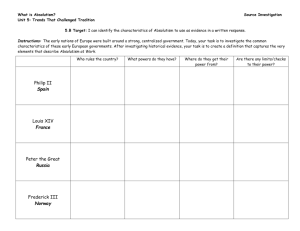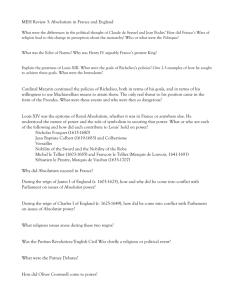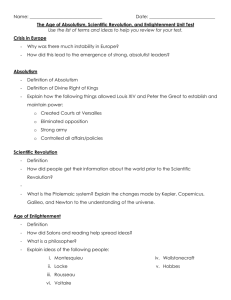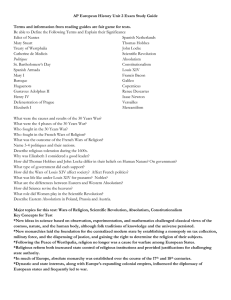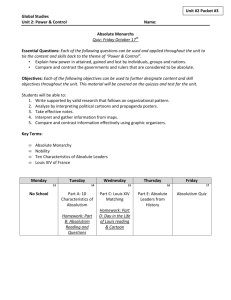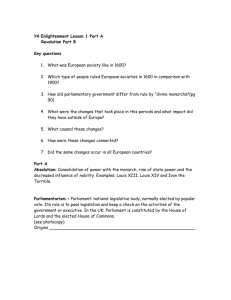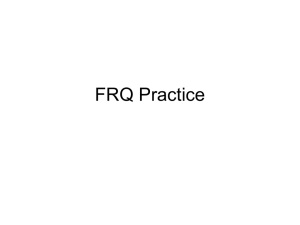Absolutism in Early Modern Europe
advertisement
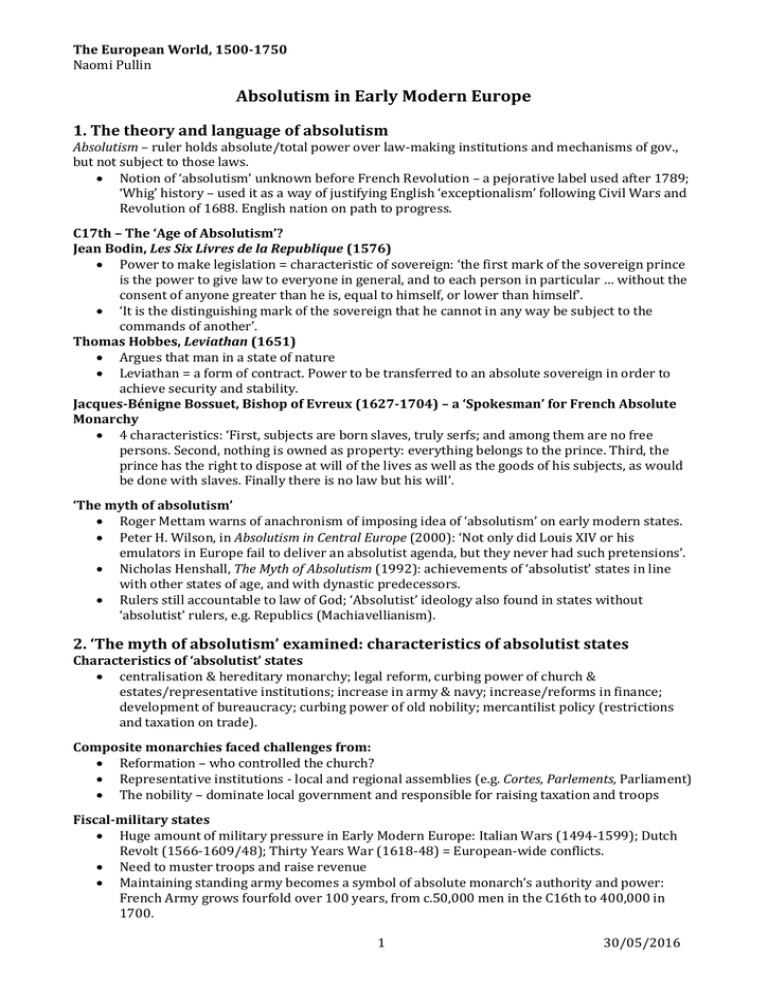
The European World, 1500-1750 Naomi Pullin Absolutism in Early Modern Europe 1. The theory and language of absolutism Absolutism – ruler holds absolute/total power over law-making institutions and mechanisms of gov., but not subject to those laws. Notion of ‘absolutism’ unknown before French Revolution – a pejorative label used after 1789; ‘Whig’ history – used it as a way of justifying English ‘exceptionalism’ following Civil Wars and Revolution of 1688. English nation on path to progress. C17th – The ‘Age of Absolutism’? Jean Bodin, Les Six Livres de la Republique (1576) Power to make legislation = characteristic of sovereign: ‘the first mark of the sovereign prince is the power to give law to everyone in general, and to each person in particular … without the consent of anyone greater than he is, equal to himself, or lower than himself’. ‘It is the distinguishing mark of the sovereign that he cannot in any way be subject to the commands of another’. Thomas Hobbes, Leviathan (1651) Argues that man in a state of nature Leviathan = a form of contract. Power to be transferred to an absolute sovereign in order to achieve security and stability. Jacques-Bénigne Bossuet, Bishop of Evreux (1627-1704) – a ‘Spokesman’ for French Absolute Monarchy 4 characteristics: ‘First, subjects are born slaves, truly serfs; and among them are no free persons. Second, nothing is owned as property: everything belongs to the prince. Third, the prince has the right to dispose at will of the lives as well as the goods of his subjects, as would be done with slaves. Finally there is no law but his will’. ‘The myth of absolutism’ Roger Mettam warns of anachronism of imposing idea of ‘absolutism’ on early modern states. Peter H. Wilson, in Absolutism in Central Europe (2000): ‘Not only did Louis XIV or his emulators in Europe fail to deliver an absolutist agenda, but they never had such pretensions’. Nicholas Henshall, The Myth of Absolutism (1992): achievements of ‘absolutist’ states in line with other states of age, and with dynastic predecessors. Rulers still accountable to law of God; ‘Absolutist’ ideology also found in states without ‘absolutist’ rulers, e.g. Republics (Machiavellianism). 2. ‘The myth of absolutism’ examined: characteristics of absolutist states Characteristics of ‘absolutist’ states centralisation & hereditary monarchy; legal reform, curbing power of church & estates/representative institutions; increase in army & navy; increase/reforms in finance; development of bureaucracy; curbing power of old nobility; mercantilist policy (restrictions and taxation on trade). Composite monarchies faced challenges from: Reformation – who controlled the church? Representative institutions - local and regional assemblies (e.g. Cortes, Parlements, Parliament) The nobility – dominate local government and responsible for raising taxation and troops Fiscal-military states Huge amount of military pressure in Early Modern Europe: Italian Wars (1494-1599); Dutch Revolt (1566-1609/48); Thirty Years War (1618-48) = European-wide conflicts. Need to muster troops and raise revenue Maintaining standing army becomes a symbol of absolute monarch’s authority and power: French Army grows fourfold over 100 years, from c.50,000 men in the C16th to 400,000 in 1700. 1 30/05/2016 The European World, 1500-1750 Naomi Pullin Rulers need to implement measures to encourage economic growth to raise revenue through taxes. State consolidation: France Reforms of Cardinal Richelieu under Louis XIII increase crown control over French provinces Louis XIV uses increases size and power of Intendants to rule over provinces – reformed regional financial and judicial systems and enforced laws 1515 – 1 royal official for every 4,700 inhabitants; 1665 – 1 royal official for every 380 State consolidation: Russia Economic reforms to finance wars with Sweden (Charles XI) Inspired by mercantilist tenets of Western Europe – national power and prestige are created through system of taxable wealth. Increases taxes, including ‘beard tax’. By 1719 Taxes account for 53 per cent of state revenue. 1718 - Establishes two colleges for commerce and mines and manufacturing Court culture and the nobility Court at centre of European politics and central to absolutist states; construction of Versailles Palace, France finished 1682. Courtiers wield great political power and try and garner favour of the ruler through patronage. Louis XIV’s relationship with his nobles = backbone of his state. Louis’s daily routine structured around ceremony, e.g. Royal Lever (rising); rules of etiquette governed behaviour of courtiers. Leads to revolution of manners – Norbert Elias ‘civilising process’ – behaviour became linked to privilege. 3. The British alternative? The ‘Glorious Revolution’, 1688-89 1. Fears of ‘popery’ Fear that Catholicism had increasing influence at Court: conversion of James duke of York, the future James II, to Catholicism. James II starts to promote Catholics to positions of power and permits religious toleration of Catholics 2. Fears of arbitrary government Concerns that both Charles II and James II rule without consent. Both rule in 1680s without summoning parliament; also concerns that they are packing it with Court supporters or by trying to regulate elections to ensure a compliant Parliament. French style government? Worries about emulation/admiration of Louis XIV Charles II enters into alliance with France to support wars against Dutch Republic. 1688: The First Modern Revolution? James II deposed in Dec. 1688; William III and Mary II begin joint rule of England Steve Pincus (2011): England enters into a phase of modern democracy; change in English governance and rebalancing of powers between Crown and Parliament Revolution introduces: Constitution – Bill of Rights; Frequent Parliaments; Ideology of consent and liberty; Religious toleration A ‘Dutch invasion’? Popular violence against catholic targets – violence esp. in Ireland and Scotland until 1692 1707 Formal union between England and Scotland; 75 per cent of Scots opposed to union. War with France 1689-97 (Nine Years’ War) – cost £49 million (three times average expenditure during James II’s reign) 1702-1714 War of Spanish Succession – 170,000 British troops in Europe > unprecedented taxation (three times level under Charles II, £5m raised in taxes each year) Huge growth of national debt. Did the eclipse of absolutism mean a free state? Paradoxically, leads to a stronger ‘fiscal-military’ state. 2 30/05/2016
